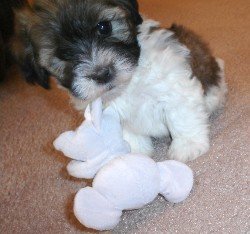 The Havanese, often dubbed “the national dog of Cuba,” is known for its charming personality and, of course, its beautiful coat. Havanese dogs come in a wide array of coat colors, each with its unique charm. In this comprehensive guide, we’ll explore the fascinating world of Havanese colors, from the standard to the rare, and delve into the genetics, care, and significance of these coat variations.
The Havanese, often dubbed “the national dog of Cuba,” is known for its charming personality and, of course, its beautiful coat. Havanese dogs come in a wide array of coat colors, each with its unique charm. In this comprehensive guide, we’ll explore the fascinating world of Havanese colors, from the standard to the rare, and delve into the genetics, care, and significance of these coat variations.
Understanding Havanese Breed
Origin and History
Before we dive into the realm of colors, let’s briefly touch on the Havanese breed’s history. These small, affectionate dogs have a long and storied past, tracing their lineage back to 15th-century Cuba. They were cherished by Cuban aristocracy, making them a beloved companion dog throughout history.
Temperament and Personality
Havanese are known for their friendly and outgoing personalities. They thrive on human companionship, making them ideal family pets. Their temperament is often described as lively, affectionate, and intelligent, which endears them to many dog lovers.
The Variety of Havanese Coat Colors
Havanese can come in most any color imaginable, from pastels in solid and parti’s to dark color. These dogs can showcase a diverse range of coat colors, making each individual unique. Here are the main ones:
Solid Colors

Solid-colored Havanese are elegant and come in various shades. Popular solid colors include white, cream, black, chocolate, and silver. These dogs exude simplicity and grace.
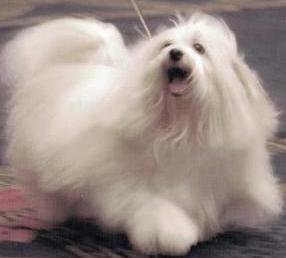
Parti-Color

Parti-color Havanese sport a predominantly white coat with patches of another color. These patches can be in various patterns and shades, creating a striking appearance.
This is Fancy, you can see she is a black and white parti color. She is very unique with having silver on top of her head as well as some brown around her face.
This is Biscuit as a 5 week old pup, she is a silver parti color, (a parti color must have it’s coloring on it’s back broken with a second color somewhere. You can see she is black on her ears and her spot in the center of her body. This black will lighten to a silver by the time she is 2 (as you can see in the next photo’s) the silver change process is very slow in havanese, but shows up around 4 weeks of age in puppies.
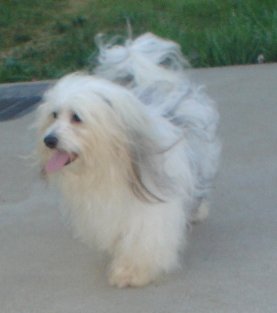
This is the same dog, Biscuit. As a 4 year old in the picture, you can see she kept her silvering color and also got cream on her face as she aged. The cream was quite a surprise, since she showed no signs of cream as a puppy.

Black parti colored puppy

Gold sable parti colored puppy

Black parti colored puppy
Parti colors can come in many colors: black parti, red parti, gold sable parti, red sable parti , dark sable parti.
Here are some more variations of parti-colors:


Sable Havanese
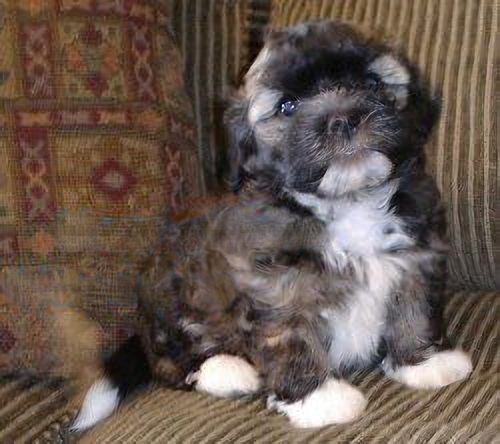
Sable Havanese have a mix of dark and light hairs, giving their coat a multi-dimensional appearance. Their colors can range from dark brown to shades of red.
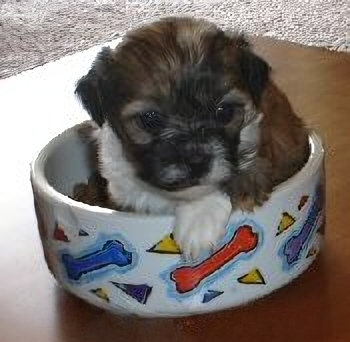
Brindle
Brindle Havanese boast a unique striped pattern on their coat. This pattern adds an exotic flair to their appearance, making them stand out in a crowd.
Merle
Merle Havanese have a marbled or dappled coat, often with patches of lighter and darker shades. This rare coat color is captivating to behold.
Rare and Unique Havanese Coat Colors
Beyond the standard colors, Havanese can exhibit rare and unusual coat variations. These can include lavender, blue, and even champagne-colored coats. These rare colors are highly sought after among Havanese enthusiasts.
Pastel Colored Havanese (including whites)


Dark Colored Havanese are the Blacks, Chocolates and Havana browns.

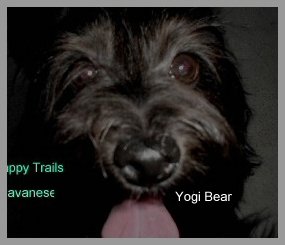
 This is beautiful little girl is a coal black havanese, with just a tiny bit of of white on her chin.
This is beautiful little girl is a coal black havanese, with just a tiny bit of of white on her chin.
 A black havanese puppy that will stay black as an adult is born completely black with no red tint or brownish tint on the fur. A puppy with the reddish or brownish tint will turn a silver or steel blue by adulthood.
A black havanese puppy that will stay black as an adult is born completely black with no red tint or brownish tint on the fur. A puppy with the reddish or brownish tint will turn a silver or steel blue by adulthood.
As you can see in the following picture of the little girl (my granddaughter) holding the 3 puppies.
Both Katie and and Jenny have a brownish tint to them.
His is not to be confused with a chocolate or a havana brown, it is a puppy that is born black that will turn silver by adulthood. In the following pictures of the girls, you see Jenny and Katie at 8 weeks of age with the silver coloring coming in at the roots of her hair.
Также признак серебристой взрослой собаки: в возрасте 4 недель на подушечках лап начинают появляться серебристые волоски.
Also a very indication of a silver adult dog, at 4 weeks of age, silver hairs start coming in on the pads of their feet.
Hard to believe it is the same puppies, from 5 weeks to 8 weeks of age.
Irish Pied Havanese

This cute little guy is a black and tan irish pied, what a beautiful boy.

Pied Bald Havanese
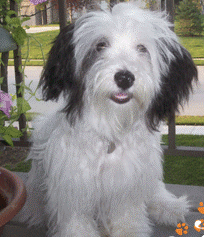
Genetics Behind Havanese Coat Colors
The coat color of a Havanese is determined by its genetics. Understanding the genetic makeup of these dogs can shed light on how different colors are inherited and why certain variations occur.
How to Care for Havanese Coats
Grooming Tips
Maintaining a Havanese’s coat requires regular grooming. Brushing, trimming, and bathing are essential to keep their fur in optimal condition.
Coat Health
The health of a Havanese’s coat is indicative of its overall well-being. Proper nutrition, hydration, and parasite control are vital aspects of coat health.
Havanese Colors and Show Standards
In the world of dog shows, Havanese coat colors are subject to specific standards. Understanding these standards can help breeders and enthusiasts determine which colors are show-worthy.
Popular Color Combinations
Some Havanese enthusiasts prefer specific color combinations. We’ll explore popular pairings and why they appeal to certain individuals.
Choosing the Right Color for Your Havanese
The coat color of your Havanese can be a personal choice, but it’s important to consider factors such as temperament, grooming requirements, and your own preferences when making your decision.
Conclusion
In the world of Havanese dogs, coat colors add a layer of intrigue and fascination. Whether you prefer the classic solid colors or the rare and exotic variations, each Havanese is a unique and cherished companion. Understanding the genetics, care, and significance of coat colors can enhance your appreciation for this delightful breed.
Frequently Asked Questions
What is the most common Havanese coat color?
The most common Havanese coat color is white, followed by cream and various shades of brown.
Can Havanese coat colors change over time?
Havanese coat colors can evolve as they age, and puppies may not display their final colors until they are a few months old. We described it in more detail in here>>.
How often do Havanese change color?
The color of the havanese coat can change as puppies grow from 6 months old, with the final color often appearing by about 12 months of age.
Can Havanese with rare coat colors be more expensive?
Yes, Havanese with rare coat colors are often more expensive due to their uniqueness and demand.
How can I ensure my Havanese’s coat remains healthy and vibrant?
Regular grooming, a balanced diet, and routine vet check-ups are essential for maintaining a Havanese’s coat health.
What should I consider when choosing a Havanese color for my family?
Consider your family’s preferences, the dog’s temperament, and your willingness to commit to grooming when choosing a Havanese color that suits your lifestyle.
Is coat color an indicator of temperament?
No, a Havanese’s coat color does not determine its temperament. Temperament is influenced by genetics and upbringing.
Can I show Havanese with non-standard colors?
In official dog shows, Havanese are typically judged by breed standards, which include specific color requirements. Non-standard colors may not be eligible for show.